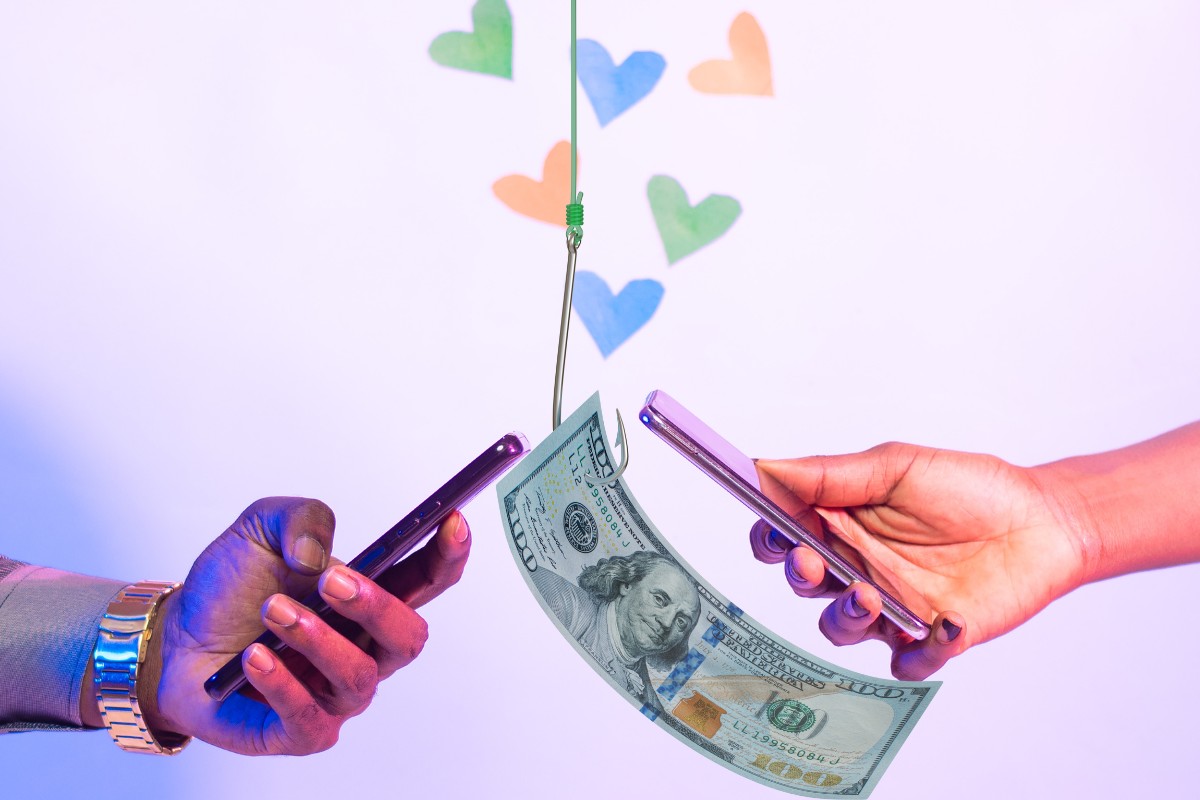There is little doubt that social media has been beneficial to billions of people around the world.
The ability to connect with anyone at any time means loved ones can stay in contact and new friends or partners can be made at any time.
Of course, this has led to online dating, in many cases an excellent way to meet the right person when you have limited free time.
There are currently over 2,500 dating sites in the US alone!
That’s a lot of places to look for someone to love.
Unfortunately, it’s also a great spot for people to deceive each other.
You may have already been catfished, but once you realize how many people get catfished a year you’ll realize you’re not on your own.
Post Contents
- 1 Key Statistics
- 2 What Is Catfishing?
- 3 How Many People Get Catfished A Year?
- 3.1 1. In The US, Approximately 20,000 People Experience Catfishing A Year
- 3.2 2. 20% Of Men Report Being Multiple Catfish Victims!
- 3.3 3. 22% Of victims Have Sent Nude Pictures To Their Catfisher
- 3.4 4. 85% Of Catfish Scams Start On Facebook
- 3.5 5. 27% Of Online Daters Have Been Catfished
- 3.6 6. Sickness Is The Primary Reason For Scammers Requesting Money
- 3.7 7. 64% Of Catfishers Are Women
- 3.8 8. Approximately 35% Of Catfish Victims Experience Psychological Issues
- 4 Catfish Red Flags
- 5 Summing Up
Key Statistics
- In the US, approximately 20,000 people experience catfishing a year
- 20% of men report being multiple catfish victims!
- 22% of victims have sent nude pictures to their catfisher
- 85% of catfish scams start on Facebook
- 27% of online daters have been catfished
- Sickness is the primary reason for scammers requesting money
- 64% of catfishers are women
- Approximately 35% of catfish victims experience psychological issues
What Is Catfishing?
Catfishing is the term given to people who create a fake identity online.
This is commonly done on dating apps although a fake identity could be created on social media and other online sites.
The people that create a fake identity may wish to upset other people, or even target a specific individual.
Equally, it can be done to anonymously fulfill a wish that may otherwise be difficult to ask for.
However, while this can be distressing, the biggest issue is when catfishing is used to scam someone.
In short, they build a relationship with you and you feel it’s genuine.
Then, they share a distressing story and convince you to help them out financially.
That is often the end of the relationship and, because the profile is fake, you will never see or hear from them again.
It can be difficult to track the person behind the catfish account and many people don’t report the incident because it is embarrassing.
Being a victim of catfishing is nothing to be embarrassed about.
As the following statistics show, it’s more common and costly than you think.
How Many People Get Catfished A Year?

1. In The US, Approximately 20,000 People Experience Catfishing A Year
Around the world, approximately five billion people are online.
Nearly 300 million of these people are in the US.
That’s the majority of the US population.
In this regard, 20,000 victims of catfishing seems a relatively small number.
However, to each of the victims, it’s not a small thing.
Catfishing can relieve them of funds or their dignity.
The latest figures reveal that catfishing in 2020 cost victims across the globe around $600 million.
The average victim loses $600, although some lose considerably more.
Of course, when you lose $600 it’s enough to be felt but not always enough to report to the authorities and suffer the subsequent embarrassment.
Naturally, this figure is probably considerably lower than the actual number of victims.
The reports only show those that do report it.
(Oberlo)
2. 20% Of Men Report Being Multiple Catfish Victims!
Surprisingly, men are just as likely to be catfished as women.
In fact, in a recent study by Sugar Cookie, it was discovered that 20% of men had been a victim of catfishing multiple times.
In many cases the victims have felt lonely and been sucked in by a well-crafted profile, thinking they have finally connected with the perfect one.
Some studies even show that men are more likely to be victims than women.
Several surveys have suggested that 43% of men have been catfish victims and just 25% of women.
It’s possible that this is because the catfisher appeals to the male ego, allowing them to ‘help’ their love interest and feel more masculine.
(Sugar Cookie)
3. 22% Of victims Have Sent Nude Pictures To Their Catfisher
Catfishers create fake accounts and identities in order to embarrass you or to get money.
The distress story is a great way to get financial help.
However, it takes time to build this type of relationship, making it a long con for the catfisher.
In contrast, getting someone to send nude pictures of themselves allows the catfisher to either blackmail you or sell the photos online to others.
It’s easier than you think as the catfisher will almost certainly send you risque and naked pictures first.
The difference is, the images they are sending you aren’t them.
According to the latest reports, 22% of people will send a nude photo after being asked.
What’s perhaps more concerning is that a survey of catfishers found that only 20% asked for nudes.
In other words, 2% of people supplied nude pictures without being asked for them!
A specific example includes a catfisher known as ‘White PLastic’.
His method was to create a fake celebrity account and pose as a celebrity on YouTube.
As he built rapport with people he asked for nude pictures.
Any nudes received were sold to others.
White Plastic said it was the victim’s own fault as they were daft enough to send nude pictures.
(Insider)
4. 85% Of Catfish Scams Start On Facebook

There are approximately 3 billion Facebook users.
That’s over half the number of people online in the world.
While most users are genuine, it’s estimated there are 86 million fake accounts on Facebook.
It’s not surprising, catfishers find it easy to create a fake account on Facebook.
Additionally, there are millions of users which makes it easier to find a victim.
Unfortunately, with so many users, Facebook finds it very difficult to keep track of all the accounts and have the right safeguards in place to ensure every account is genuine.
The result is anyone can create a fake account and start chatting to other users.
This ease of use means that catfishers often use Facebook to meet people.
It’s estimated that 85% of catfishing scams start out on Facebook.
While Facebook could do more to protect users from fake accounts, it also helps if users are aware of the red flags.
That’s the indicator that an account is not genuine.
5. 27% Of Online Daters Have Been Catfished
According to statistics over 350 million people dated online during 2022.
It should be noted that this number continues to rise.
Screen time and digital meetings have increased dramatically post-pandemic.
The latest figures suggest that at least half of all online daters eventually meet in person and, at the time of meeting, they trust their online partner.
For many of these people, the experience is positive.
People appear as they are although they may have lied about finances or some other small details.
However, the whole dating online system relies on trust and many people never get to meet their date as they are not the person they think they are.
Catfishers admit to preying on people’s emotions in order to gain their trust and then ask them for money.
It’s an effective tactic.
Studies show that 20% of online daters have been asked for money within the last year.
Alongside this, 27% of online daters feel they have been catfished within the last year.
Unfortunately, the study doesn’t reveal what the other 7% of people were asked for when being catfished or if they simply realized before they were asked.
(VPN Alert)
6. Sickness Is The Primary Reason For Scammers Requesting Money
For most people, logging onto a dating app means they are lonely and looking for love.
It should be noted that these apps are different to the ones looking for a one-night hook-up.
It’s harder to build trust when people are looking for sex instead of love.
Scammers will create fake profiles and say all the right things to their online partners, building a relationship and trust.
Once the victim feels there is a real connection the catfisher can ask for money.
While there are several popular approaches, the most common is to claim that they or a loved one is sick.
This is the approach in 24% of catfishing incidents.
In many cases they will ask for a relatively small amount, stating that they have most of the funds.
The best scammers won’t even ask, they will set the scenario so that the victim offers the funds.
Going for smaller amounts, such as hundreds of dollars means the victim is less likely to go to the police.
It can also open the door for the scammer to ask for more.
(VPN Alert)
7. 64% Of Catfishers Are Women
Catfishers can be men or women, and there are plenty of examples of both.
However, according to studies, 64% of catfishers are women.
That’s significantly more than male catfishers.
It’s likely that women find it easier to catfish.
In general, men will accept something at face value and are unlikely to lie about feelings of romance.
That makes it easier for them to fall for a woman’s charms.
Of course, men are more likely to lie about their financial status.
A recent study found that 40% of male online daters lied about their finances.
In contrast, women are more likely to lie about their age, which makes little difference to most male suitors.
Women are perceived as being better at expressing and detecting emotions.
This gives them the advantage when building a relationship, particularly when they are fabricating it to catfish the victim.
It’s worth noting men are 25% more likely to be a victim of a catfishing scam than women.
(Inner Peace Behavioural Health)
8. Approximately 35% Of Catfish Victims Experience Psychological Issues

It’s not unusual for people to suffer emotionally after they’ve been a victim of catfishing.
The whole point of the scam is to create an emotional attachment.
While the scammer will avoid emotional feelings, the victim will develop trust, admiration, and even feelings of love.
This is natural when in a relationship and necessary for the catfish to work.
However, once the catfisher has got what they wanted from the relationship, they will simply disappear.
In 35% of cases this results in the victim developing serious psychological issues.
This includes feelings of anxiety, paranoia, and even depression.
It can be extremely difficult for someone to recover mentally without help from a professional.
(Sugar Cookie)
Catfish Red Flags
If you’re trying to build a relationship online with someone then you need to be aware of catfishing and the signs which suggest you could become a victim.
Knowing the following will help you spot the scammers and end the relationship before you become a victim.
Of course, it may be difficult to end a budding relationship when you’re looking for love.
However, if they are displaying the following signs you need to be strong and do so.
There is someone out there for you!
- Their Friends
The first thing you should look at when chatting to someone on a dating app is what friends they have.
Most people have a mixture of male and female in all shapes and sizes.
If your online date only seems to have friends of the opposite sex and they share similar characteristics, it’s likely they are attempting to catfish multiple people at the same time.
- Excuses
Most people don’t ask to meet- straight away.
However, it’s a common request after a connection has been built.
If you’re asking to meet and are given an excuse then it could be genuine.
However, if this happens repeatedly then that’s a serious red flag.
They clearly aren’t who they say they are.
Prior to meeting, it’s a good idea to chat online via video.
This will allow you to verify their appearance matches their profile.
If it doesn’t, or they refuse to chat on video, be very suspicious.
- Requests For Funds
Naturally, if any romantic interest online asks for funds you should treat it as a red flag.
Reverse the process and consider whether you would ask them for money.
The answer is likely to be no.
That means you should be saying no to them.
- Inconsistencies
When someone is catfishing multiple people simultaneously it can be hard to keep up with all the stories they tell.
That means, there are likely to be inconsistencies in what they say.
You’ll instinctively know when this is happening and need to trust your gut.
It’s highly likely that you’re being lied to and this may be to catfish you.
Summing Up
When you look at how many people get catfished the simple answer is too many.
This is a scam which plays on the emotions and no one deserves that, especially people who are lonely and looking for love.
Unfortunately, it is surprisingly common and catfishing occurrences are increasing.
The best thing you can do is to be aware of the red flags and never send pictures or money until you’ve met someone in person.
You need to be certain they are who they say they are and that’s only possible face-to-face.






























